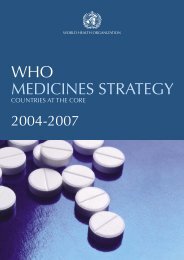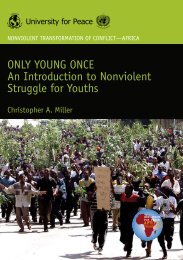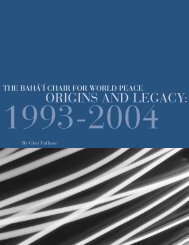environmental degradation as a cause of conflict in - Steiner Graphics
environmental degradation as a cause of conflict in - Steiner Graphics
environmental degradation as a cause of conflict in - Steiner Graphics
You also want an ePaper? Increase the reach of your titles
YUMPU automatically turns print PDFs into web optimized ePapers that Google loves.
PREFACEThese essays were orig<strong>in</strong>ally oral presentations made to the conference on <strong>environmental</strong><strong>degradation</strong> and <strong>conflict</strong> <strong>in</strong> Darfur. The essays represent orig<strong>in</strong>al and<strong>in</strong>formed contributions towards the understand<strong>in</strong>g <strong>of</strong> the root <strong>cause</strong>s <strong>of</strong> <strong>conflict</strong> <strong>in</strong>Darfur and they provide ide<strong>as</strong> which may help <strong>in</strong> the resolution <strong>of</strong> the <strong>conflict</strong>.The current <strong>conflict</strong> <strong>in</strong> Darfur resulted when a civil war between the government<strong>of</strong> Sudan (GOS) and two rebel movements erupted, on a background <strong>of</strong> a complex<strong>conflict</strong> system, which w<strong>as</strong> becom<strong>in</strong>g progressively more ethnically oriented and<strong>in</strong>cre<strong>as</strong><strong>in</strong>gly violent. The government resorted to force <strong>in</strong> order to crush the rebel’smovements, but the army w<strong>as</strong> struggl<strong>in</strong>g to fight the well-tra<strong>in</strong>ed, armed and wellmotivatedrebels. The government allegedly opted for an alliance with the ArabP<strong>as</strong>toralists militi<strong>as</strong>, who have a vested <strong>in</strong>terest <strong>in</strong> fight<strong>in</strong>g this war, <strong>as</strong> most <strong>of</strong> therebels were from competitive tribes.Enormous efforts have been concentrated on resolv<strong>in</strong>g the immediate crisis <strong>in</strong>Darfur. These efforts fall <strong>in</strong>to the three categories <strong>of</strong>: humanitarian <strong>as</strong>sistance,improvement <strong>in</strong> the security situation to allow safe return <strong>of</strong> refugees and reach<strong>in</strong>ga political settlement between the rebel groups and the GOS. This may eventuallyresolve the present crisis but leaves the door open for future <strong>conflict</strong>. There is anessential need to address the root <strong>cause</strong> <strong>of</strong> the problem – competition over dw<strong>in</strong>dl<strong>in</strong>gnatural resources.The <strong>as</strong>sociation between <strong>conflict</strong> and the ecological changes h<strong>as</strong> been documentedover the years <strong>in</strong> several forms. The long periods <strong>of</strong> drought, which characterizedthe region for the l<strong>as</strong>t four decades, resulted <strong>in</strong> mount<strong>in</strong>g poverty and widespreadpopulation movement, which provided the <strong>cause</strong>s for <strong>conflict</strong>. The drought,which occurred <strong>in</strong> the eighties, w<strong>as</strong> the most dramatic <strong>in</strong> its effects and it followeda period <strong>of</strong> drought <strong>in</strong> the seventies. These ecological changes mostly affected theNorthern part <strong>of</strong> Darfur compell<strong>in</strong>g the Nomads to immigrate southwards <strong>in</strong> search<strong>of</strong> water and herd<strong>in</strong>g ground, which resulted <strong>in</strong> <strong>conflict</strong> with sedentary tribes, likethe Fur and M<strong>as</strong>alit.Darfur h<strong>as</strong> been the site <strong>of</strong> <strong>in</strong>ter-communal <strong>conflict</strong> for generations. However, <strong>in</strong>the eighties the <strong>conflict</strong>s <strong>in</strong> Darfur became more vicious and many <strong>of</strong> them acquiredan ethnic dimension, between the Arabs on the one hand and non-Arab identitygroups. The transformation <strong>of</strong> <strong>conflict</strong>, which occurred <strong>in</strong> the eighties, w<strong>as</strong> <strong>cause</strong>dby several factors:











